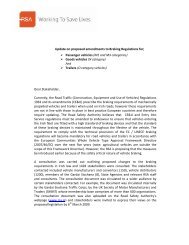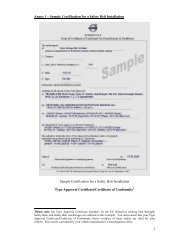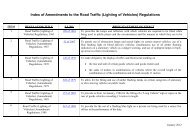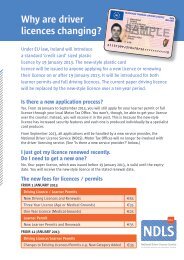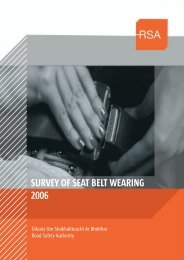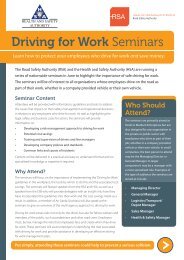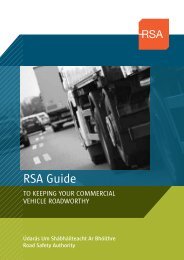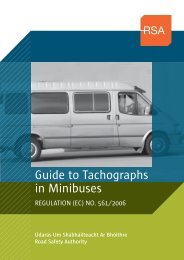NCT Manual. - National Car Testing Service
NCT Manual. - National Car Testing Service
NCT Manual. - National Car Testing Service
Create successful ePaper yourself
Turn your PDF publications into a flip-book with our unique Google optimized e-Paper software.
52<br />
NATIONAL CAR TEST (<strong>NCT</strong>) MANUAL 2012<br />
MECHANICAL BRAKE COMPONENTS<br />
Method of <strong>Testing</strong><br />
Examine the mechanical components of the brakes which can be seen without dismantling. Look particularly for:<br />
1. Badly chafed rods or levers.<br />
2. Frayed or seized cables.<br />
3. Badly damaged, corroded, seized or incorrectly fitted rods, levers or linkages.<br />
4. Wear in rod or cable ends.<br />
5. Wear in eyes of relay levers.<br />
6. Wear in clevis pins, bolts, stationary pins, pivots.<br />
7. Absence of locking devices on clevis pins.<br />
8. Excessively worn, contaminated, incorrectly adjusted brake linings or pads.<br />
9. Fractured, damaged, insecure, misaligned brake drums or discs.<br />
10. Any obstruction to free movement in the system.<br />
11. Any abnormal movement of levers, rods or cables indicating maladjustment.<br />
12. Security of brake back plates or discs (including transmission brakes).<br />
NOTES<br />
1. In the absence of wear indicators or manufacturer’s recommendations regarding brake lining or disc pad<br />
wear, a figure of 1.5mm (1⁄16”) should be taken as a minimum thickness for bonded linings/pads and<br />
.40mm (1⁄64”) above the head of the attaching rivet as a minimum thickness of riveted linings.<br />
2. Where no facility is provided for inspection of brake shoes/pads, item (8) above will not apply.<br />
3. The wheels shall be chocked and the parking brake released while this test is being carried out.<br />
ITEM<br />
Brake Rods/Levers/Cables/ Linkages/<br />
Pivots<br />
Brackets, Mounting Bolts, Split Pins or<br />
Other Retaining Devices<br />
Brake Linings<br />
Brake Drums/Discs/Backplates<br />
Actuating Levers<br />
Free Movement of Brake Rod/ Levers/<br />
Cables etc.<br />
REASONS FOR FAILURE<br />
1 Missing, damaged, cracked, corroded, seized, obstructed or worn.<br />
2 Incorrectly fitted.<br />
3 Missing, loose or worn.<br />
4 Brake linings contaminated.<br />
5 Incorrectly adjusted.<br />
6 Brake shoes or pads in need of replacement (see note (1)).<br />
7 Missing, contaminated, obviously damaged, askew or insecure.<br />
8 Damaged, insecure or in need of adjustment.<br />
9 Operating over centre.<br />
10 Danger of brakes locking (vehicles with air<br />
brakes: S-cams locking over).<br />
11 Restricted.<br />
82



